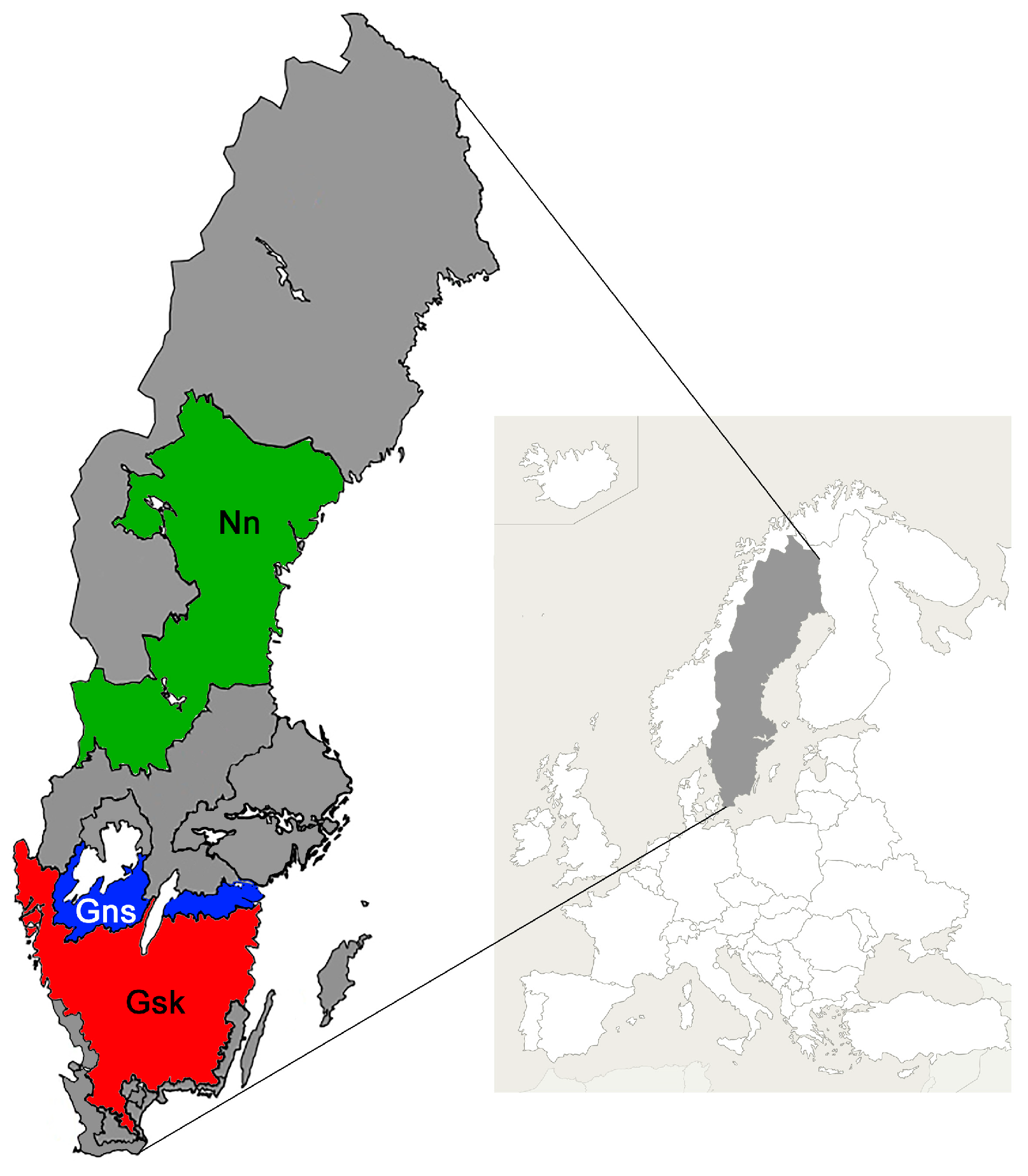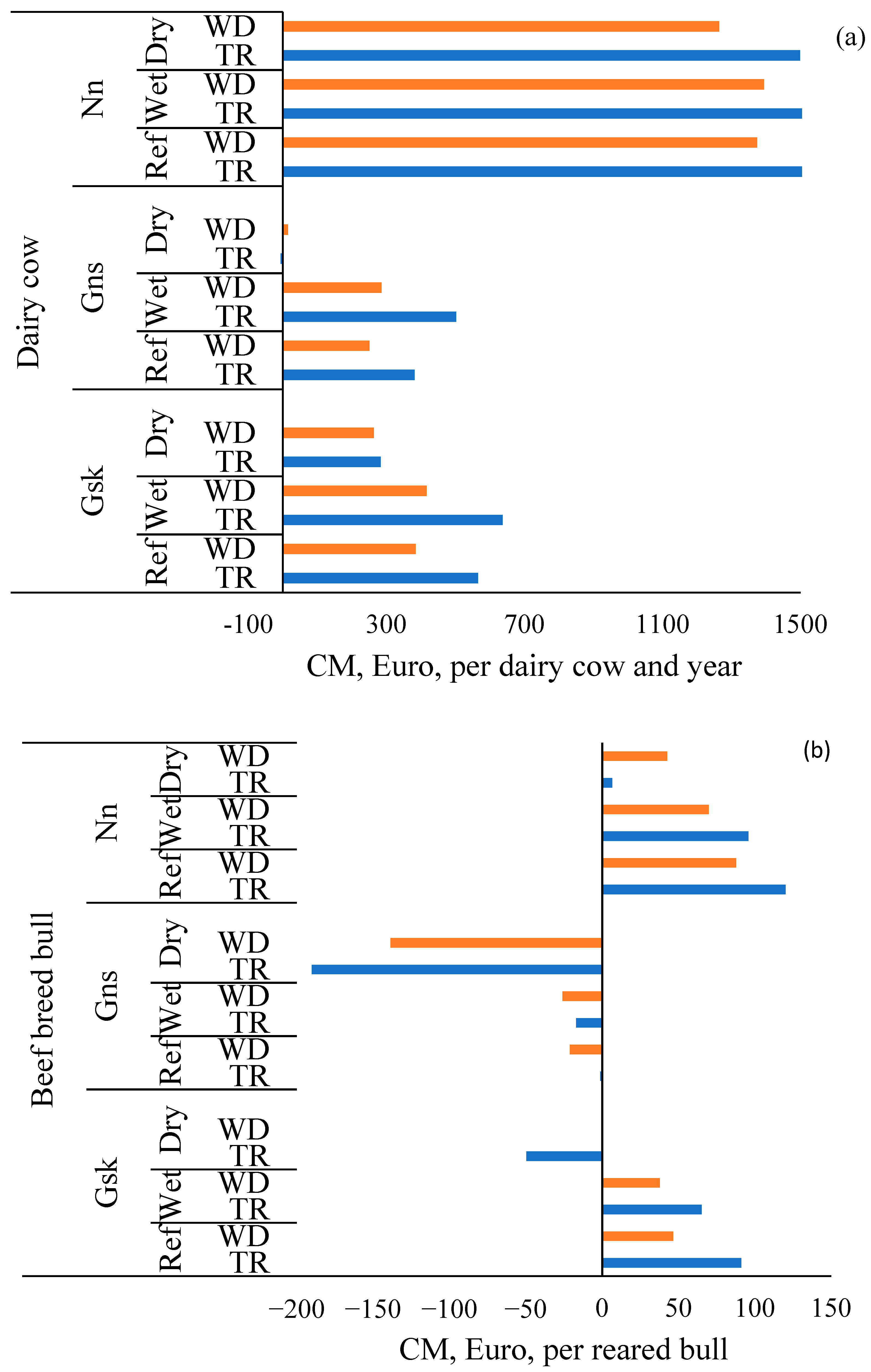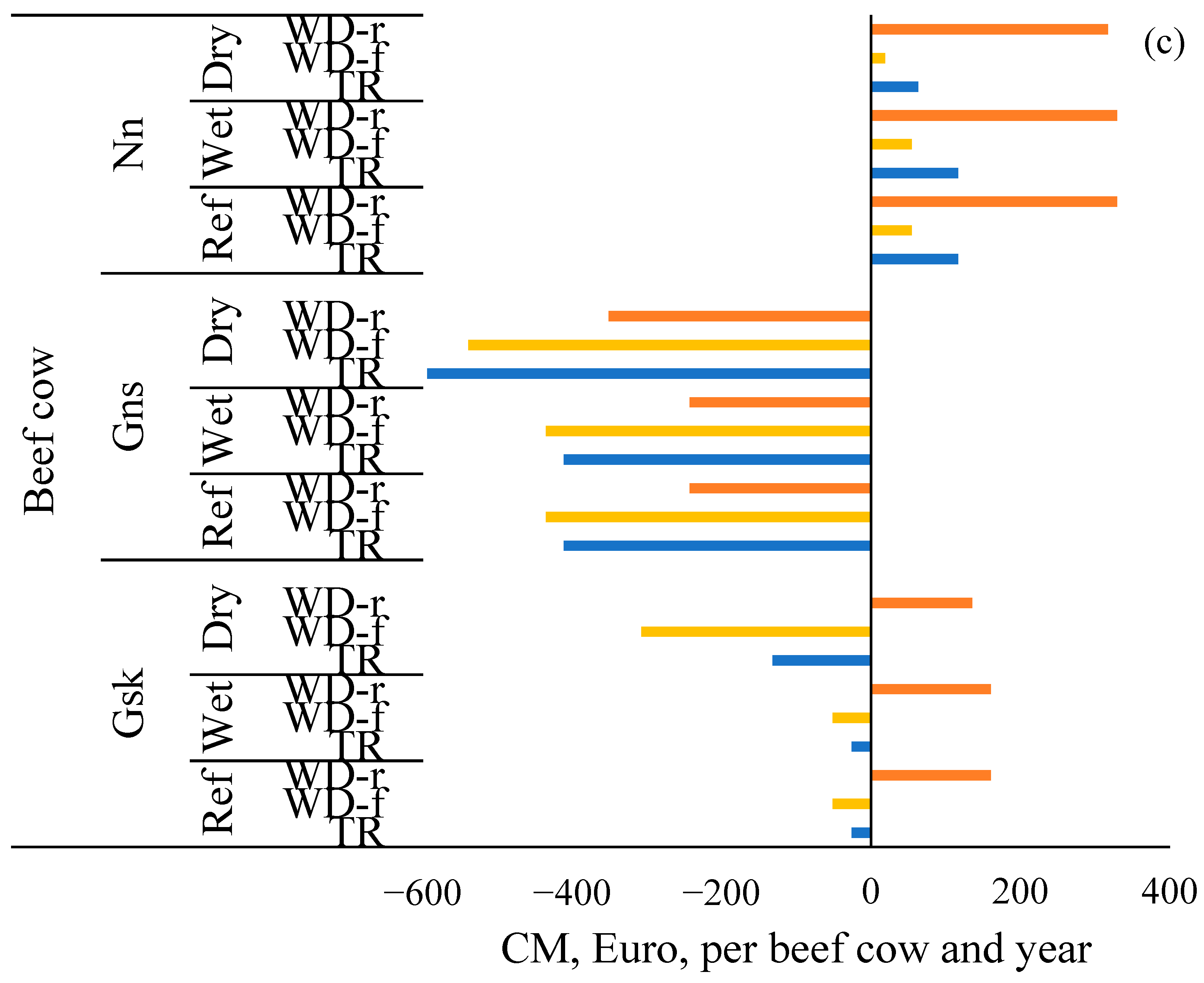In a Changing World—An Economical Comparison Between Traditional and Wet-And-Drought-Resistant Grasses in Swedish Cattle Production Under Different Weather Scenarios
Simple Summary
Abstract
1. Introduction
- Alternative grasses are relatively more competitive compared to traditional grasses under dry and wet weather conditions than under normal conditions due to relatively higher yield in the alternative grasses under extreme weather conditions.
- Alternative grasses are relatively more competitive compared to traditional grasses in extensive systems such as cow-calf production, than in intensive systems such as dairy production, due to the lower nutritive value in the alternative grasses.
2. Materials and Methods
2.1. Biological Data
2.2. Geographical Regions
2.3. Weather Scenarios
2.4. Economical Calculations
2.5. Sensitivity Analysis
3. Results
3.1. Basic Calculation
3.1.1. Normal Weather Conditions
3.1.2. Dry Weather Conditions
3.1.3. Wet Weather Conditions
3.1.4. Fluctuating Weather Conditions
3.2. Sensitivity Analysis with Rent Cost for Land
4. Discussion
5. Conclusions
Supplementary Materials
Author Contributions
Funding
Institutional Review Board Statement
Informed Consent Statement
Data Availability Statement
Acknowledgments
Conflicts of Interest
References
- IPCC. IPCC: Summary for Policymakers; Contribution of Working Groups I, II and III to the Sixth Assessment Report of the Intergovernmental Panel on Climate Change; IPCC: Geneva, Switzerland, 2023; p. 184. [Google Scholar] [CrossRef]
- SMHI Klimat–Statistik, Forskning Och Vägledning|SMHI. Available online: https://www.smhi.se/klimat (accessed on 29 February 2024).
- Bertrand, A.; Tremblay, G.F.; Pelletier, S.; Castonguay, Y.; Bélanger, G. Yield and nutritive value of timothy as affected by temperature, photoperiod and time of harvest. Grass Forage Sci. 2008, 63, 421–432. [Google Scholar] [CrossRef]
- Johansen, A.; Nordang, L. A Comparison between meadow fescue and timothy silage I. Feeding experiments with slaughter bulls. Nor. J. Agric. Sci. 1993, 7, 381–399. [Google Scholar]
- Mäkinen, H.; Kaseva, J.; Virkajärvi, P.; Kahiluoto, H. Gaps in the capacity of modern forage crops to adapt to the changing climate in northern Europe. Mitig. Adapt. Strateg. Glob. Change 2018, 23, 81–100. [Google Scholar] [CrossRef]
- Ghesquière, M.; Humphreys, M.W.; Zwierzykowski, Z. Festulolium. In Fodder Crops and Amenity Grasses; Boller, B., Posselt, U.K., Veronesi, F., Eds.; Handbook of Plant Breeding; Springer: New York, NY, USA, 2010; pp. 288–311. ISBN 978-1-4419-0760-8. [Google Scholar]
- Casler, M.D.; Kallenbach, R.L.; Brink, G.E. Cool-season grasses for humid areas. In Forages; John Wiley & Sons, Ltd.: Ames, IO, USA, 2020; pp. 297–311. ISBN 978-1-119-43666-9. [Google Scholar]
- Halling, M.A.; Sandström, B.; Hallin, O.; Larsson, S. Vallväxter till slåtter och bete samt grönfoderväxter. Sortval för södra, mellersta och norra Sverige 2020/2021/Forage Species for Cutting, Grazing and Green Fodder. Varieties for South, Central and Northern Sweden 2020/2021; Department of Crop Production Ecology, Swedish University of Agricutural Sciences: Uppsala, Sweden, 2021. [Google Scholar]
- Drapeau, R.; Bélanger, G.; Tremblay, G.F.; Michaud, R. Rendement et valeur nutritive de la fétuque élevée cultivée en régions à faibles degrés-jours de croissance. Can. J. Plant Sci. 2005, 85, 369–376. [Google Scholar] [CrossRef]
- Richard, A.-M.; Gervais, R.; Tremblay, G.F.; Bélanger, G.; Charbonneau, É. Tall fescue as an alternative to timothy fed with or without alfalfa to dairy ows. J. Dairy Sci. 2020, 103, 8062–8073. [Google Scholar] [CrossRef] [PubMed]
- Chen, L.; Auh, C.; Chen, F.; Cheng, X.; Aljoe, H.; Dixon, R.A.; Wang, Z. Lignin deposition and associated changes in anatomy, enzyme activity, gene expression, and ruminal degradability in stems of tall fescue at different developmental stages. J. Agric. Food Chem. 2002, 50, 5558–5565. [Google Scholar] [CrossRef]
- Novo-Uzal, E.; Taboada, A.; Rivera, A.; Flores, G.; Barceló, A.R.; Masa, A.; Pomar, F. Relationship between hydroxycinnamic acid content, lignin composition and digestibility of maize silages in sheep. Arch. Anim. Nutr. 2011, 65, 108–122. [Google Scholar] [CrossRef]
- Adesogan, A.T.; Arriola, K.G.; Jiang, Y.; Oyebade, A.; Paula, E.M.; Pech-Cervantes, A.A.; Romero, J.J.; Ferraretto, L.F.; Vyas, D. Symposium review: Technologies for improving fiber utilization. J. Dairy Sci. 2019, 102, 5726–5755. [Google Scholar] [CrossRef]
- Arelovich, H.M.; Abney, C.S.; Vizcarra, J.A.; Galyean, M.L. Effects of dietary neutral detergent fiber on intakes of dry matter and net energy by dairy and beef cattle: Analysis of published data. Prof. Anim. Sci. 2008, 24, 375–383. [Google Scholar] [CrossRef]
- Collins, M.; Casler, M.D. Forage quality of five cool-season grasses. I. Cultivar effects. Anim. Feed. Sci. Technol. 1990, 27, 197–207. [Google Scholar] [CrossRef]
- Sousa, D.O.; Murphy, M.; Hatfield, R.; Nadeau, E. Effects of harvest date and grass species on silage cell wall components and lactation performance of dairy cows. J. Dairy Sci. 2021, 104, 5391–5404. [Google Scholar] [CrossRef] [PubMed]
- Holmström, K.; Sousa, D.; Hessle, A. Productive performance of beef bulls fed tall fescue silage or meadow fescue silage and complemented with cereal grains. Acta Agric. Scand. Sect. A—Anim. Sci. 2024, 1–5. [Google Scholar] [CrossRef]
- Jardstedt, M.; Nadeau, E.; Nielsen, M.; Nørgaard, P.; Hessle, A. The Effect of feeding roughages of varying digestibility prepartum on energy status and metabolic profiles in beef cows around parturition. Animals 2020, 10, 496. [Google Scholar] [CrossRef] [PubMed]
- Hallin, O.; Holmström, K.; Nadeau, E. Vallfröblandningar Anpassade Till Antal Skördar-Forage Seed Mixtures Adapted to Number of Harvests; Department of Animal Environment and Health, Swedish University of Agricultural Sciences: Skara, Sweden, 2023; p. 31. [Google Scholar]
- Volden, H. NorFor-The Nordic Feed Evaluation System; EAAP Publications; Wageningen Academic Publishers: Wageningen, The Netherlands, 2011. [Google Scholar]
- Nadeau, E.; Hallin, O. Meddelande från södra jordbruksdistriktet; Konference Report: 6–7 December; University of Agricultural Sciences: Partnerskap Alnarp, Swedish, 2016; p. 31. [Google Scholar]
- Palmborg, C. Reed canary grass. In Depth Studies of Varieties; Swedish University of Agricultural Sciences, Department of Agricultural Research for northern Sweden: Umeå, Sweden, 2016; p. 14. [Google Scholar]
- Joel, A.; Nilsdotter-Linde, N.; Wesström, I. Går det att höja vallskördarna med enstaka bevattningsgivor–vad händer med kvaliteten? L1-0268 och L1-0269; Försöksrapport Sverigeförsöken: Klippan, Sweden, 2023; pp. 21–30. [Google Scholar]
- Kottek, M.; Grieser, J.; Beck, C.; Rudolf, B.; Rubel, F. World Map of the Köppen-Geiger Climate Classification Updated. Meteorol. Z. 2006, 15, 259–263. [Google Scholar] [CrossRef]
- Swedish Board of Agriculture Agricultural Statistics. Available online: https://jordbruksverket.se/om-jordbruksverket/jordbruksverkets-officiella-statistik/jordbruksstatistisk-sammanstallning (accessed on 18 January 2024).
- Swedish Board of Agriculture Stöd till Lantbrukare och Verksamma på Landsbygden. Available online: https://jordbruksverket.se/stod (accessed on 18 January 2024).
- Agriwise Agriwise-Smart Kalkylering. Available online: https://www.agriwise.se/web (accessed on 18 January 2024).
- Arla. Arlapris. 2023. Available online: https://www.arla.se/om-arla/agare/arlapris/ (accessed on 18 January 2024).
- HKScan Agri HKScan Agri notering 2023. Available online: https://www.hkscanagri.se/notering (accessed on 18 January 2024).
- Swedish Board of Agriculture Priser och Marknadsinformation för Livsmedel. Available online: https://jordbruksverket.se/mat-och-drycker/handel-och-marknad/priser-och-marknadsinformation-for-livsmedel (accessed on 18 January 2024).
- Hedlund, S.; Lindqvist, S.; Andersson, S. (HS Västra, Karlstad, Sweden). Personal communication, 2023.
- Holmström, K.; Kumm, K.-I.; Andersson, H.; Hessle, A. Labour in suckler cow herds–A study on enterprises in southern Sweden. Acta Agric. Scand. Sect. A—Anim. Sci. 2023, 73, 49–62. [Google Scholar] [CrossRef]
- Bostad, E.; Swensson, C.; Pinzke, S. Labour input in specialist beef bull production in Sweden. Agric. Eng. Int. CIGR J. 2011, 13. [Google Scholar]
- Nelson, B.-O. Kalkylmodell för Nötköttsproduktion; Skogs- och Lantarbetsgivareförbundets Analysgrupp: Ängelholm, Sweden, 2002. [Google Scholar]
- Öhman, K. (Lantmännen, Sweden). Personal communication, 2024.
- Berlin-Thorell, K. (Rådgivarna i Sjuhärad, Sweden). Persoanl communication, 2020.
- Neuman, L. (Spirina Consult, Timmele, Sweden). Personal communication, 2024.
- Länsstyrelsen Västra Götaland Bidragskalkyler 2023-Konventionell Produktion. Available online: https://www.lansstyrelsen.se/vastra-gotaland.html (accessed on 18 January 2024).
- Holmström, K.; Kumm, K.-I.; Andersson, H.; Nadeau, E.; Segerkvist, K.A.; Hessle, A. Economic incentives for preserving biodiverse semi-natural pastures with calves from dairy cows. J. Nat. Conserv. 2021, 62, 126010. [Google Scholar] [CrossRef]
- Jørgensen, M.; Torp, T.; Mølmann, J.A.B. Impact of waterlogging and temperature on autumn growth, hardening and freezing tolerance of timothy (Phleum Pratense). J. Agron. Crop Sci. 2020, 206, 242–251. [Google Scholar] [CrossRef]
- Thorvaldsson, G.; Tremblay, G.F.; Tapani Kunelius, H. The effects of growth temperature on digestibility and fibre concentration of seven temperate grass species. Acta Agric. Scand. Sect. B—Soil Plant Sci. 2007, 57, 322–328. [Google Scholar] [CrossRef]
- Shalloo, L.; Dillon, P.; O’Loughlin, J.; Rath, M.; Wallace, M. Comparison of a pasture-based system of milk production on a high rainfall, heavy-clay soil with that on a lower rainfall, free-draining soil. Grass Forage Sci. 2004, 59, 157–168. [Google Scholar] [CrossRef]
- Muñoz-Ulecia, E.; Martín-Collado, D.; Bernués, A.; Peral, A.T.; Casasús, I.; Villalba, D. Can traditional management practices help mountain livestock farms in the Spanish Pyrenees cope with climate change? Reg. Environ. Change 2024, 24, 15. [Google Scholar] [CrossRef]
- Moore, K.J.; Lenssen, A.W.; Fales, S.L.; Collins, M.; Nelson, C.J.; Redfearn, D.D. (Eds.) Factors affecting forage quality. In Factors Affecting Forage Quality, in Forages: The Science of Grassland Agriculture; John Wiley & Sons, Ltd.: Hoboken, NJ, USA, 2020; pp. 701–717. ISBN 978-1-119-43666-9. [Google Scholar]
- Sousa, D.O.; Murphy, M.; Larsson, A.; Hatfield, R.; Takahashi, J.; Nadeau, E. Effects of Grass Species on Cell Wall Components and Milk Production of Dairy Cows; Konference Report: 7–8 Februari; Department of Crop Production Ecology: Uppsala, Sweden, 2023; pp. 105–108. [Google Scholar]
- Sousa, D.; Murphy, M.; Hatfield, R.; Nadeau, E. Effects of grass species and harvest date on cell wall components and feed efficiency of dairy cows. Animal 2024, 18, 101256. [Google Scholar] [CrossRef] [PubMed]
- Ruelle, E.; Delaby, L.; Wallace, M.; Shalloo, L. Using models to establish the financially optimum strategy for Irish dairy farms. J. Dairy Sci. 2018, 101, 614–623. [Google Scholar] [CrossRef]
- Finneran, E.; Crosson, P.; O’Kiely, P.; Shalloo, L.; Forristal, D.; Wallace, M. Stochastic simulation of the cost of home-produced feeds for ruminant livestock systems. J. Agric. Sci. 2012, 150, 123–139. [Google Scholar] [CrossRef]
- Kumm, K.-I.; Hessle, A. Economic comparison between pasture-based beef production and afforestation of abandoned land in Swedish forest districts. Land 2020, 9, 42. [Google Scholar] [CrossRef]



Disclaimer/Publisher’s Note: The statements, opinions and data contained in all publications are solely those of the individual author(s) and contributor(s) and not of MDPI and/or the editor(s). MDPI and/or the editor(s) disclaim responsibility for any injury to people or property resulting from any ideas, methods, instructions or products referred to in the content. |
© 2025 by the authors. Licensee MDPI, Basel, Switzerland. This article is an open access article distributed under the terms and conditions of the Creative Commons Attribution (CC BY) license (https://creativecommons.org/licenses/by/4.0/).
Share and Cite
Holmström, K.; Kumm, K.-I.; Andersson, H.; Jardstedt, M.; Sousa, D.; Hessle, A. In a Changing World—An Economical Comparison Between Traditional and Wet-And-Drought-Resistant Grasses in Swedish Cattle Production Under Different Weather Scenarios. Animals 2025, 15, 295. https://doi.org/10.3390/ani15030295
Holmström K, Kumm K-I, Andersson H, Jardstedt M, Sousa D, Hessle A. In a Changing World—An Economical Comparison Between Traditional and Wet-And-Drought-Resistant Grasses in Swedish Cattle Production Under Different Weather Scenarios. Animals. 2025; 15(3):295. https://doi.org/10.3390/ani15030295
Chicago/Turabian StyleHolmström, Kristina, Karl-Ivar Kumm, Hans Andersson, Mikaela Jardstedt, Dannylo Sousa, and Anna Hessle. 2025. "In a Changing World—An Economical Comparison Between Traditional and Wet-And-Drought-Resistant Grasses in Swedish Cattle Production Under Different Weather Scenarios" Animals 15, no. 3: 295. https://doi.org/10.3390/ani15030295
APA StyleHolmström, K., Kumm, K.-I., Andersson, H., Jardstedt, M., Sousa, D., & Hessle, A. (2025). In a Changing World—An Economical Comparison Between Traditional and Wet-And-Drought-Resistant Grasses in Swedish Cattle Production Under Different Weather Scenarios. Animals, 15(3), 295. https://doi.org/10.3390/ani15030295





